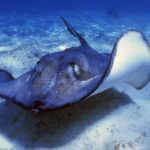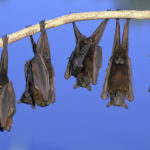Dugongs
 Dugong is an aquatic mammal from the order of sirens, like manatee (there are 3 species of manatees) and a steller cow (extinct species). Of the family of dugongs, they are the only ones who have survived to this day. The very word “dugong” comes from the Malaysian “duyung” – a sea maiden or a mermaid. But, honestly speaking, this animal is least like a mermaid or a siren, although there is some similarity under the water – the tail structure and protruding mammary glands could well suggest the image of a mermaid that is rich in imagination of sailors.
Dugong is an aquatic mammal from the order of sirens, like manatee (there are 3 species of manatees) and a steller cow (extinct species). Of the family of dugongs, they are the only ones who have survived to this day. The very word “dugong” comes from the Malaysian “duyung” – a sea maiden or a mermaid. But, honestly speaking, this animal is least like a mermaid or a siren, although there is some similarity under the water – the tail structure and protruding mammary glands could well suggest the image of a mermaid that is rich in imagination of sailors.
Dugongs do not see well, but they hear very well. The males have small tusks. Root teeth are devoid of roots and enamel, in both jaws there are 5-6 molars on each side, and in males there are also incisors.
In the process of feeding, dugons practically plow the lower lip of the bottom of the lagoon, uprooting the roots of algae, leaving characteristic strips on the bottom, it can be determined that the “sea cows” have recently grazed. At the same time, a large amount of silt rises. Algae and their roots dugongs grind with the help of powerful root teeth. Before eating the plant, the dugong rinses it in the water, shaking its head from side to side.
Dugongs can hold under water for 10-15 minutes, after which they rise to the surface to inhale air. In a day, one animal needs to eat about 40 kilograms of plants and algae, so most of the time they are busy searching for food. They swim very leisurely and calmly, and, as a rule, do not pay attention to divers. During feeding, a dugong can fearlessly accompany small fish swimming alongside its muzzle.
The animals seem rather slow, but that’s not entirely true, under water dugong floats on average with a speed of up to 10 km / h, and if you scare it – it can reach speeds of up to 18 km / h. They are silent, they make sharp sounds only when they are frightened. Poorly tolerate bondage, worse than all of the family of sirens, so they can rarely be found in water parks and attractions.



























